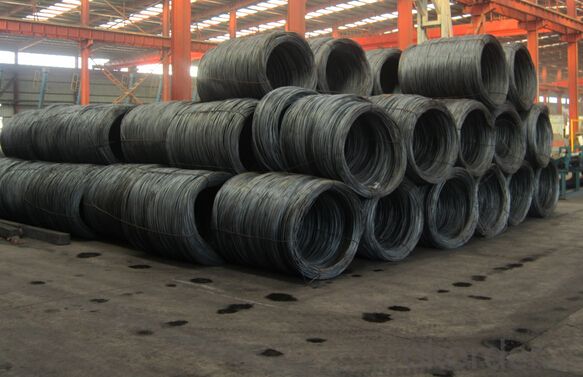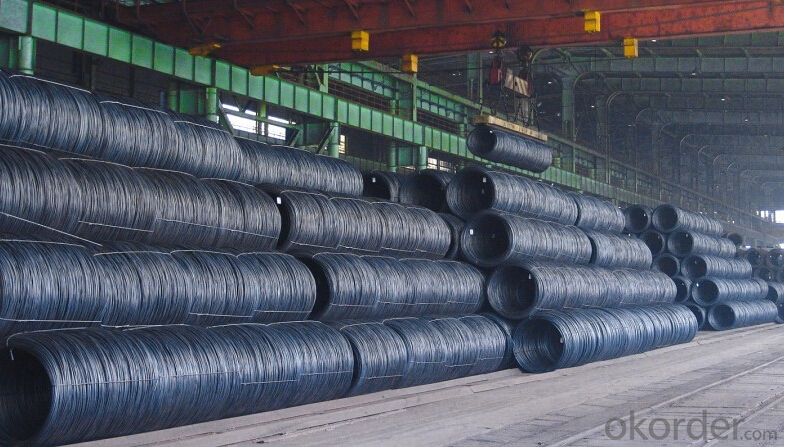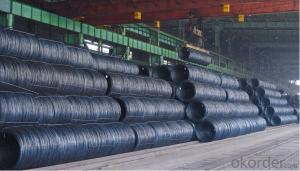HIGH QUALITY WIRE ROD
- Loading Port:
- China Main Port
- Payment Terms:
- TT OR LC
- Min Order Qty:
- -
- Supply Capability:
- -
OKorder Service Pledge
Quality Product, Order Online Tracking, Timely Delivery
OKorder Financial Service
Credit Rating, Credit Services, Credit Purchasing
You Might Also Like
Quick Details
| Place of Origin: | Brand Name: | Model Number: | |||
| Material: | white: |
Packaging & Delivery
| Packaging Detail: | the package of the wire rod steel for construction is standard exporting package |
| Delivery Detail: | 30d upon recipt of L/C |
Specifications
the wire rod steel for construction that we offer have been used in civil construction work for years.
SPECIFICATION
1: WIRE ROD IN COIL
2. STANDARD: AISI,ASTM,BS,DIN,GB,JIS
3. STEEL GRAD: Q195--235/SAE1006B/SAE1008B/SA31012B/SDA31015B/SA31018B/SA31022B
4. SIZE: 5--22MM

1) the products that we offer haven been used in civil constrction work for years
2) meet different requirment
3) we can offer accordingly with different demands



- Q:What are the advantages of using steel wire rod in mining applications?
- There are several advantages of using steel wire rod in mining applications. Firstly, steel wire rod offers high strength and durability, making it suitable for withstanding the harsh conditions and heavy loads in mining operations. Additionally, steel wire rod has excellent resistance to corrosion, which is crucial in underground mining environments where moisture and chemicals are present. Moreover, steel wire rod is highly flexible and can be easily bent or shaped to meet specific mining requirements, offering versatility in various applications. Lastly, steel wire rod is readily available and cost-effective, making it a cost-efficient choice for mining companies.
- Q:How is steel wire rod used in the manufacturing of wire forms for recreational equipment?
- Steel wire rod is an essential component used in the manufacturing of wire forms for recreational equipment. This type of wire has high tensile strength, durability, and flexibility, making it ideal for creating various wire forms that are commonly found in recreational equipment such as playground structures, sports equipment, and outdoor fixtures. In the production of wire forms for recreational equipment, steel wire rod is initially processed through a series of steps to ensure its quality and desired properties. The wire rod is first drawn through a series of dies to reduce its diameter and increase its length. This process, known as wire drawing, results in a wire that is consistent in size and has improved tensile strength. Once the steel wire rod has been drawn, it can be further manipulated to create different wire forms. For instance, it can be bent, cut, or welded to form intricate shapes that are required for specific recreational equipment. The flexibility of steel wire rod allows for the production of various wire forms, such as loops, hooks, rings, and coils, which are crucial components in different recreational equipment. These wire forms made from steel wire rod are then incorporated into the manufacturing process of recreational equipment. For example, in playground structures, steel wire rod is used to create strong and secure loops or hooks that connect different components together, providing stability and strength to the overall structure. In sports equipment, steel wire rod is often used to form durable and resilient frames for products such as basketball hoops, soccer goals, or fencing materials. Additionally, steel wire rod is used in the manufacturing of wire forms for outdoor fixtures like swings, hammocks, and bike racks. These wire forms are designed to withstand constant usage, exposure to harsh weather conditions, and heavy loads. Steel wire rod ensures that these wire forms are strong, reliable, and long-lasting, ensuring the safety and enjoyment of users. In conclusion, steel wire rod plays a vital role in the manufacturing of wire forms for recreational equipment. Its high tensile strength, durability, and flexibility make it a preferred choice in creating various wire forms that serve as essential components in recreational equipment, providing stability, strength, and safety to users.
- Q:How is steel wire rod used in the manufacturing of wire forms for automotive seat belts?
- Steel wire rod is a crucial component in the manufacturing of wire forms for automotive seat belts. The wire rod is first processed and shaped into the required form using advanced machinery and techniques. This form is then utilized to create the intricate design and structure of the seat belt, ensuring its strength and durability. Steel wire rod is chosen for this purpose due to its exceptional strength and high tensile properties. It provides the necessary resilience and flexibility required to withstand the stresses and forces experienced by seat belts during normal usage and potential accidents. Once the wire forms are created, they are further processed and treated to enhance their performance characteristics. This may involve heat treatment, galvanization, or coating processes to improve their resistance to corrosion, wear, and tear. The wire forms are then assembled with other components, such as buckles and retractors, to complete the seat belt assembly. The strength and quality of the steel wire rod used significantly contribute to the overall safety and reliability of the seat belt system. In conclusion, steel wire rod plays a vital role in the manufacturing of wire forms for automotive seat belts. It provides the necessary strength, durability, and flexibility to ensure the safety and performance of these critical safety devices.
- Q:What are the common industry qualifications for steel wire rod professionals?
- Common industry qualifications for steel wire rod professionals can vary depending on the specific role and level of expertise required. However, some of the common qualifications include a degree or certification in materials science, metallurgy, or mechanical engineering. Additionally, specialized certifications such as Certified Welding Inspector (CWI) or Certified Materials Professional (CMP) can also be beneficial in demonstrating expertise in the field. Experience working with steel wire rod production processes and knowledge of industry standards and regulations are also highly valued qualifications.
- Q:How are steel wire rods used in the production of fishing lines?
- To enhance the strength and durability of fishing lines, steel wire rods are employed. These rods act as the backbone of the line, granting it the tensile strength needed to endure the pressure and weight imposed by sizeable fish. Typically crafted from top-notch stainless steel, the steel wire rods employed in fishing lines possess resistance to rust and corrosion. This characteristic is crucial since fishing lines are consistently exposed to water and moisture, which can lead to material deterioration over time. Throughout the manufacturing process, a protective layer, such as nylon or polymer, is applied to the steel wire rods. This coating not only bolsters their performance but also renders them more suitable for fishing purposes. It not only contributes added strength but also enhances the line's flexibility, facilitating easier casting and retrieval. Additionally, the steel wire rods determine the overall diameter and weight of the fishing line. Thicker rods result in a heavier and stronger line, while thinner rods produce a lighter and more sensitive one. This enables anglers to select a fishing line that aligns with their specific requirements and fishing conditions. Moreover, the incorporation of steel wire rods into fishing lines amplifies sensitivity, enabling anglers to detect even the most subtle nibbles or movements by fish. This proves especially advantageous in situations where fish are more cautious and necessitate a delicate approach. In conclusion, steel wire rods play a critical role in the production of fishing lines. They provide the essential strength, durability, and sensitivity required, serving as the foundation of the line to withstand the weight of large fish and resist the detrimental effects of water and corrosion.
- Q:How is steel wire rod stored and transported?
- Steel wire rod is typically stored in large coils or bundles in warehouses or outdoor yards. These coils are usually stacked on pallets or stored on racks to ensure stability and ease of access. When it comes to transportation, steel wire rod is commonly transported using trucks, trains, or ships. The coils are securely strapped or loaded onto flatbeds or containers for safe transportation to various destinations such as factories or construction sites.
- Q:What are the major steel wire rod consuming industries?
- The major steel wire rod consuming industries include construction, automotive, machinery, and electrical appliances.
- Q:What are the different types of steel wire rod coating materials?
- There are several different types of coating materials used for steel wire rods, each serving a specific purpose and offering different advantages. Some of the common types of coating materials include: 1. Zinc Coating: Zinc coating, also known as galvanizing, is one of the most widely used coatings for steel wire rods. It provides excellent corrosion resistance, protecting the wire from rust and other environmental factors. Zinc coating can be applied through hot-dipping or electroplating methods. 2. Phosphate Coating: Phosphate coating is often used as a pretreatment before applying other coatings or paints. It provides a base layer that enhances adhesion and improves corrosion resistance. Phosphate coatings are commonly used in industries such as automotive, construction, and agriculture. 3. Polymer Coating: Polymer coatings are applied to steel wire rods to provide additional protection against corrosion, abrasion, and other mechanical stresses. These coatings are often made of epoxy, nylon, or polyethylene materials, which offer excellent durability and resistance to chemicals and extreme temperatures. 4. Copper Coating: Copper coating is used to enhance the electrical conductivity of steel wire rods. It is commonly applied in the manufacturing of electrical wires and cables, where high conductivity is required. 5. Chrome Coating: Chrome coating is known for its high resistance to corrosion and wear. It is often applied to steel wire rods used in applications where they will be exposed to harsh environments or high temperatures. 6. Aluminum Coating: Aluminum coating provides a lightweight and corrosion-resistant layer to steel wire rods. It is commonly used in industries such as aerospace and automotive, where weight reduction and durability are crucial. 7. Organic Coating: Organic coatings, such as polyurethane or acrylic paints, are used to provide aesthetic appeal and protection against corrosion and UV rays. These coatings are often used in applications where the wire rods will be visible or subjected to outdoor conditions. It is important to select the appropriate coating material based on the specific requirements and intended use of the steel wire rods. Factors such as corrosion resistance, electrical conductivity, durability, and environmental conditions should be considered to ensure the optimal performance of the coated wire rods.
- Q:What are the safety considerations when working with steel wire rod?
- Some safety considerations when working with steel wire rod include wearing personal protective equipment such as gloves, safety glasses, and steel-toed boots to protect against potential injuries. It is important to handle the wire rod with caution, as it can have sharp edges or protruding ends that can cause cuts or punctures. Additionally, workers should be aware of the weight and size of the wire rod to prevent strains or back injuries when lifting or moving it. Proper storage and stacking techniques should be followed to prevent the wire rod from falling or causing tripping hazards. Finally, workers should be trained on the safe operation of any machinery or tools used in conjunction with the steel wire rod to minimize the risk of accidents or damage.
- Q:How does the corrosion resistance of steel wire rod vary with different surface treatments?
- The corrosion resistance of steel wire rod can vary significantly with different surface treatments. Surface treatments are applied to steel wire rod to enhance its resistance to corrosion and extend its lifespan. One common surface treatment for steel wire rod is galvanization, which involves applying a layer of zinc to the surface of the wire rod. This zinc coating acts as a sacrificial barrier, protecting the underlying steel from corrosion. Galvanized steel wire rod has excellent corrosion resistance and can withstand exposure to harsh environments, such as high humidity or corrosive chemicals. Another surface treatment for steel wire rod is phosphating. This process involves applying a phosphate coating to the surface of the wire rod, which enhances its corrosion resistance. Phosphating creates a protective layer that inhibits the formation of rust and prevents corrosion from spreading. Additionally, steel wire rod can be treated with various types of coatings, such as epoxy or polymer coatings. These coatings provide an extra layer of protection against corrosion, preventing moisture and corrosive substances from reaching the steel surface. Coated steel wire rod has improved resistance to corrosion and can be used in environments where direct exposure to moisture or corrosive agents is expected. It is important to note that the effectiveness of surface treatments in improving corrosion resistance may vary depending on the specific conditions and the quality of the treatment applied. Factors such as the thickness and adhesion of the coating, the presence of any defects or impurities in the treatment, and the type and concentration of corrosive substances in the environment can all impact the corrosion resistance of steel wire rod. In conclusion, the corrosion resistance of steel wire rod can be significantly enhanced by different surface treatments such as galvanization, phosphating, or the application of coatings. These treatments provide a protective barrier against corrosion, ensuring the longevity and durability of the wire rod in various environments.
1. Manufacturer Overview |
|
|---|---|
| Location | |
| Year Established | |
| Annual Output Value | |
| Main Markets | |
| Company Certifications | |
2. Manufacturer Certificates |
|
|---|---|
| a) Certification Name | |
| Range | |
| Reference | |
| Validity Period | |
3. Manufacturer Capability |
|
|---|---|
| a)Trade Capacity | |
| Nearest Port | |
| Export Percentage | |
| No.of Employees in Trade Department | |
| Language Spoken: | |
| b)Factory Information | |
| Factory Size: | |
| No. of Production Lines | |
| Contract Manufacturing | |
| Product Price Range | |
Send your message to us
HIGH QUALITY WIRE ROD
- Loading Port:
- China Main Port
- Payment Terms:
- TT OR LC
- Min Order Qty:
- -
- Supply Capability:
- -
OKorder Service Pledge
Quality Product, Order Online Tracking, Timely Delivery
OKorder Financial Service
Credit Rating, Credit Services, Credit Purchasing
Similar products
New products
Hot products
Related keywords



























